
USS President Lincoln was a troop transport in the United States Navy during World War I.

The first USS Amphion was a former German passenger liner SS Köln for Norddeutscher Lloyd from 1899–1917. Köln had been interned in Boston on the outbreak of war in Europe and confiscated in April 1917 when the United States entered the war. The ship was under the control of the United States Shipping Board (USSB) that allocated commercial type ships to military or civilian use during the war. Köln was renamed Amphion and operated by USSB for the Army as United States Army Chartered Transport (U.S.A.C.T.) Amphion as an animal transport taking mules, horses and general cargo to forces in Europe. At the end of the war the USSB allocated the ship to the Navy, which used the ship from April to September 1919 as a troop transport for returning the United States Expeditionary Force from Europe.

USS Freedom (ID-3024) was a cargo and transport ship in the United States Navy during World War I. Originally SS Wittekind for the North German Lloyd line, the ship also served as USAT Iroquois and USAT Freedom after being seized by the United States in 1917.

USS Pocahontas (SP-3044) was a transport ship for the United States Navy during World War I. She was originally SS Prinzess Irene, a Barbarossa-class ocean liner built in 1899 by AG Vulcan Stettin of Stettin, Germany, for the North German Lloyd line.

Kronprinz Wilhelm was a German ocean liner built for Norddeutscher Lloyd, a shipping company now part of Hapag-Lloyd, by the AG Vulcan shipyard in Stettin, Germany, in 1901. She was named after Crown Prince Wilhelm, son of the German Emperor Wilhelm II, and was a sister ship of SS Kaiser Wilhelm der Grosse.

Kronprinzessin Cecilie was an ocean liner built in Stettin, Germany in 1906 for North German Lloyd that had the largest steam reciprocating machinery ever fitted to a ship. The last of four ships of the Kaiser class, she was also the last German ship to have been built with four funnels. She was engaged in transatlantic service between her home port of Bremen and New York until the outbreak of World War I.
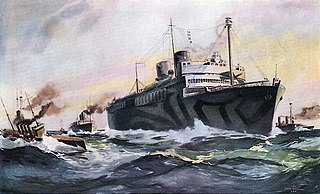
USS Siboney (ID-2999) was a United States Navy troopship in World War I. She was the sister ship of USS Orizaba (ID-1536). Launched as SS Oriente, she was soon renamed after Siboney, Cuba, a landing site of United States forces during the Spanish–American War. After her navy service ended, she was SS Siboney for the New York & Cuba Mail Steamship Co.. The ship was operated under charter by American Export Lines beginning in late 1940. During World War II she served the U.S. Army as transport USAT Siboney and as hospital ship USAHS Charles A. Stafford.

SS George Washington was an ocean liner built in 1908 for the Bremen-based North German Lloyd and was named after George Washington, the first President of the United States. The ship was also known as USS George Washington (ID-3018) and USAT George Washington in service of the United States Navy and United States Army, respectively, during World War I. In the interwar period, she reverted to her original name of SS George Washington. During World War II, the ship was known as both USAT George Washington and, briefly, as USS Catlin (AP-19), in a short, second stint in the U.S. Navy.

USS Bridgeport (AD-10/ID-3009) was a destroyer tender in the United States Navy during World War I and the years after. She was a twin-screw, steel-hulled passenger and cargo steamship built in 1901 at Vegesack, Germany as SS Breslau of the North German Lloyd line. Breslau was one of the seven ships of the Köln class of ships built for the Bremen to Baltimore and Galveston route.

USS Aeolus (ID-3005), sometimes also spelled Æolus, was a United States Navy transport ship during World War I. She was formerly the North German Lloyd liner SS Grosser Kurfürst, also spelled Großer Kurfürst, launched in 1899 that sailed regularly between Bremen and New York. At the outset of World War I the ship was interned by the United States and, when the U.S. entered the conflict in 1917, was seized and converted to a troop transport.

SS Friedrich der Grosse was a Norddeutscher Lloyd liner built in 1896 which sailed Atlantic routes from Germany and sometimes Italy to the United States and on the post run to Australia. At the outset of World War I the ship was interned by the U.S. and, when that country entered the conflict in 1917, was seized and converted to a troop transport, becoming USS Huron (ID-1408).
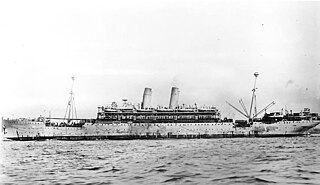
USS Princess Matoika (ID-2290) was a transport ship for the United States Navy during World War I. Before the war, she was a Barbarossa-class ocean liner that sailed as SS Kiautschou for the Hamburg America Line and as SS Princess Alice for North German Lloyd. After the war she served as the United States Army transport ship USAT Princess Matoika. In post-war civilian service she was SS Princess Matoika until 1922, SS President Arthur until 1927, and SS City of Honolulu until she was scrapped in 1933.

USS Rijndam (ID–2505) was the Holland America Line (HAL) ocean liner Rijndam, also spelt Ryndam, which was launched in Ireland in 1901 and scrapped in the Netherlands in 1929. The US requisitioned her as the United States Navy troopship USS Rijndam from 1918 until 1919. She was the first of four Holland America Line ships to be called Ryndam.
SS Duca d'Aosta was an Italian ocean liner for Navigazione Generale Italiana named after one of the Dukes of Aosta. Launched in 1908, she sailed between Italy and New York and South America for most of her career. During World War I she was employed as a troopship carrying United States troops to France as part of the United States Navy Cruiser and Transport Force. She was scrapped in 1929.
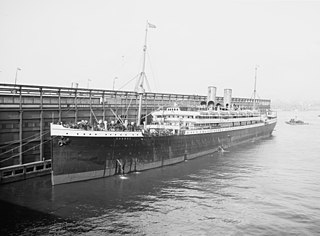
The Barbarossa class was a class of ocean liners of North German Lloyd and the Hamburg America Line of the German Empire. Of the ten ships built between 1896 and 1902, six were built by AG Vulcan Stettin, three were built by Blohm & Voss, and one was built by Schichau-Werke; all were built in Germany. They averaged 11,000 gross register tons (GRT) and featured twin screw propellers driven by quadruple-expansion steam engines.
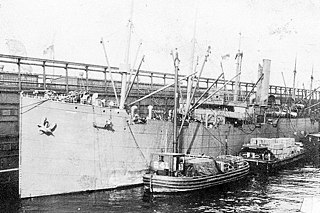
Empire Bittern was a steamship, built as a livestock-carrying cargo ship in 1902 at Belfast, Ireland as Iowa for the White Diamond Steamship Company Ltd of Liverpool. The ship was sold to the Hamburg Amerika Linie and renamed Bohemia in 1913.
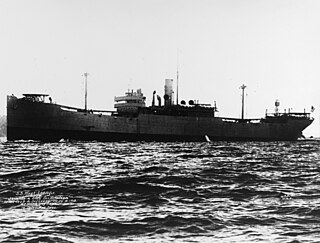
USS West Lianga (ID-2758) was a cargo ship for the United States Navy during World War I. She was later known as SS Helen Whittier and SS Kalani in civilian service under American registry, as SS Empire Cheetah under British registry, and as SS Hobbema under Dutch registry.
SS Empire Chamois was a 5,864 GRT cargo ship which was built in 1918 by Ames Shipbuilding and Drydock Co, Seattle. She was ordered by the Compagnie Générale Transatlantique but was requisitioned by the United States Navy and commissioned as USS West Mount with the pennant number ID-3202 in 1918. She was decommissioned in May 1919 and passed to the United States Shipping Board (USSB) as SS Westmount. In 1927 she was sold to the Dimon Steamship Corporation and renamed SS Pacific Redwood. She returned to the USSB in 1932 and passed to the United States Maritime Commission (USMC) in 1937. In 1940, she was passed to the Ministry of Shipping, passing to the Ministry of War Transport in 1941 and being renamed SS Empire Chamois. She was sold to Astral Shipping Co Ltd in 1946 and renamed SS Granview. In 1949 she was sold to the Compagnia Maritime del Este, Panama and renamed SS Chamois, serving until 1958 when she was scrapped. She was the last Ames-built ship afloat.

Western Maid was a 5,760 GRT cargo ship that was built in 1918 by the Northwest Steel Company, Portland, Oregon, USA. She was built for the United States Shipping Board (USSB), but was commissioned into the United States Navy on completion as USS Western Maid, with the pennant number ID-3703. In 1919 she was decommissioned and returned to the USSB. In 1937 she was passed to the United States Maritime Commission. In 1940 she was transferred to the British Ministry of Shipping and renamed Empire Cormorant, passing to the Ministry of War Transport (MoWT) in 1941. In 1945 she was scuttled in the North Atlantic with a cargo of obsolete war matériel.

SS Bulgaria was a passenger-cargo steamship built in 1898 for the Hamburg American Line ("Hapag"). During World War I, she operated as a United States Army animal and cargo ship under the names USAT Hercules and USAT Philippines, and after the war was converted into the troop transport USS Philippines (ID-1677).





















